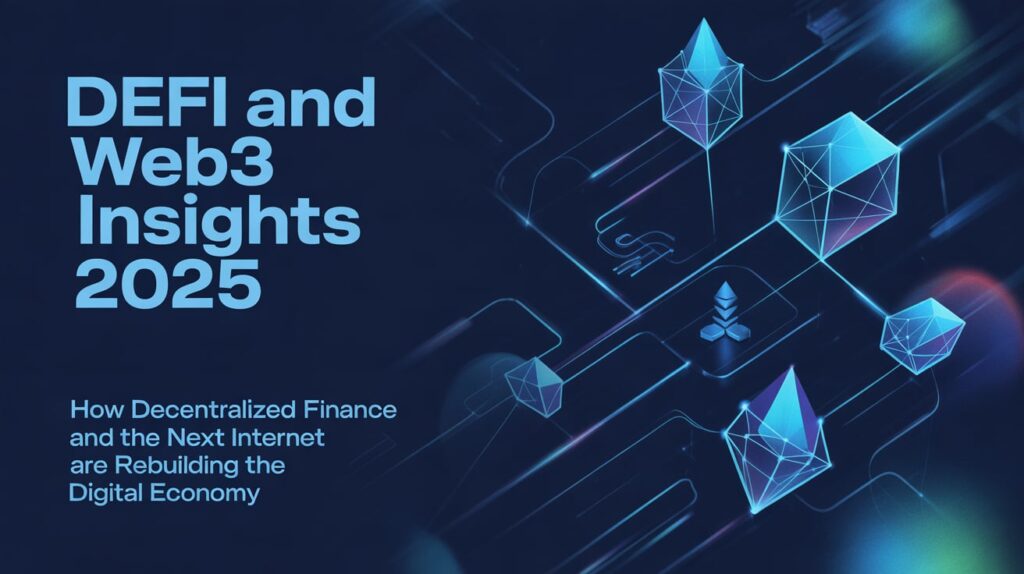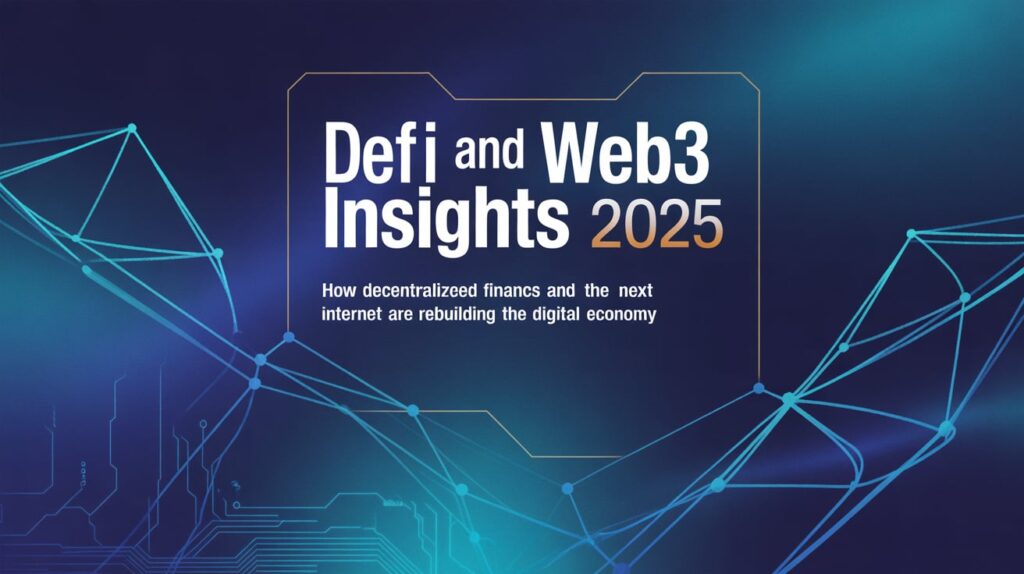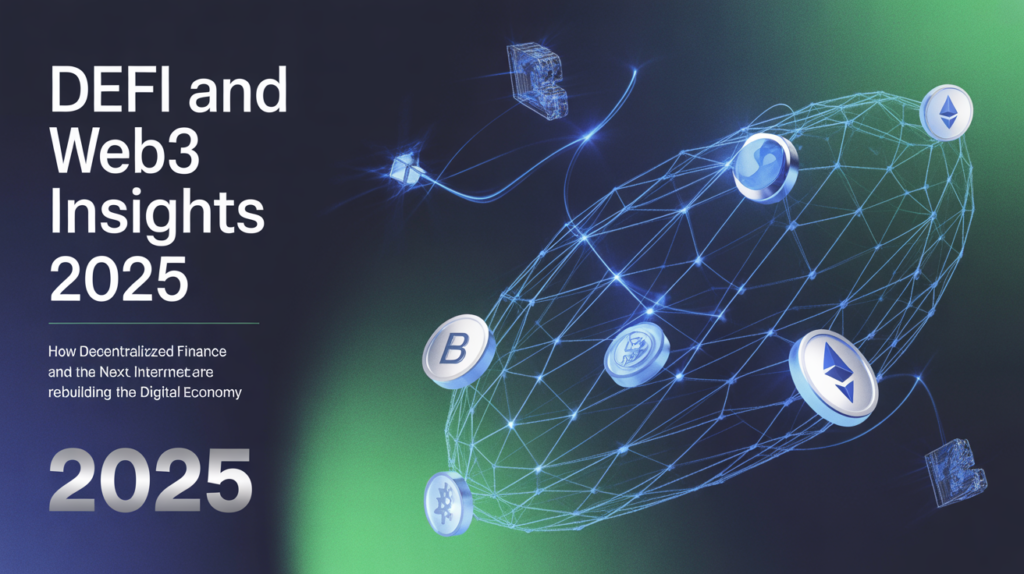DeFi and Web3 Insights 2025: How Decentralized Finance and the Next Internet Are Rebuilding the Digital Economy
As the global digital economy enters a transformative new era, BTCMARKETNEWS explores how DeFi and Web3 Insights 2025 reveal the merging paths of finance, technology, and user empowerment. The blockchain-driven revolution that began a decade ago is now reshaping every layer of the internet — from how we trade assets to how we own and control our digital identities.
In 2025, decentralized finance (DeFi) and the Web3 movement have matured from experimental innovations into powerful forces driving economic change. This article dives deep into how these technologies are redefining value creation, reshaping traditional banking, and setting the foundation for a truly decentralized digital future.
The Rise of DeFi and Web3 in 2025
DeFi and Web3 Insights 2025 show that blockchain-based ecosystems are no longer limited to early adopters and tech enthusiasts. With global participation from institutional investors, tech giants, and millions of users, decentralized finance has become an essential pillar of the global economy.
DeFi — short for decentralized finance — removes intermediaries like banks and brokers. Web3, often called the “next generation of the internet,” extends this decentralization into every digital interaction — from identity management to data ownership and payments. Together, they represent the foundation of a user-centric, transparent, and borderless financial system.
Key Trends Shaping DeFi and Web3 in 2025
1. Tokenized Real-World Assets (RWAs)
The tokenization of real-world assets has become a defining trend in DeFi and Web3 Insights 2025. From real estate and gold to carbon credits and fine art, blockchain technology now enables fractional ownership and liquidity for traditionally illiquid markets.
According to BTCMARKETNEWS, major financial institutions have started issuing tokenized bonds and ETFs on blockchain networks, enabling 24/7 global trading while reducing settlement times from days to minutes.
2. Cross-Chain DeFi Interoperability
The future of decentralized finance lies in interoperability. In 2025, cross-chain bridges and protocols like LayerZero and Polkadot enable seamless asset transfers between different blockchains.
This interconnected web of DeFi ecosystems allows users to lend, borrow, and trade across multiple chains with ease — a major step toward eliminating fragmentation and unlocking true decentralization.
3. AI-Enhanced DeFi Strategies
Artificial intelligence and machine learning are now integrated into DeFi platforms to enhance trading, yield farming, and risk management. DeFi and Web3 Insights 2025 reveal how AI algorithms analyze on-chain data to predict liquidity trends, optimize yield farming strategies, and prevent market manipulation.
BTCMARKETNEWS reports that this convergence of AI and blockchain is setting new efficiency standards, allowing even small investors to access data-driven financial tools once exclusive to hedge funds.
4. Web3 Identity and Ownership
The shift from platform-controlled data to user-owned identity is at the core of Web3. In 2025, digital wallets have become “super IDs,” allowing users to control their credentials, reputations, and digital assets across platforms.
Projects like ENS (Ethereum Name Service) and World ID are redefining digital identity, empowering individuals to verify themselves without relying on centralized corporations. This evolution represents one of the most impactful takeaways in DeFi and Web3 Insights 2025 — the dawn of user sovereignty.
5. Decentralized Autonomous Organizations (DAOs)
DAOs have become the new model for governance in 2025. These blockchain-based communities manage resources, vote on policies, and execute operations using smart contracts.
Whether funding public goods or managing DeFi treasuries, DAOs are reshaping how organizations operate online. BTCMARKETNEWS notes that several Fortune 500 companies now participate in DAO initiatives to explore transparent governance models.
The Economic Impact of DeFi and Web3
A. Financial Inclusion
By removing intermediaries, DeFi platforms give access to financial services for billions of unbanked people. In emerging economies, users can now lend, borrow, and invest using stablecoins without needing a traditional bank account.
B. Lower Transaction Costs
Traditional banking fees and remittance costs are being replaced by low-cost, blockchain-based alternatives. BTCMARKETNEWS estimates that blockchain payments could reduce global remittance costs by over 60% by 2026.
C. Transparent and Programmable Finance
DeFi introduces programmable money — smart contracts that execute automatically when conditions are met. This eliminates human bias and delays, fostering transparency and trust.
As DeFi and Web3 Insights 2025 emphasize, programmable finance is enabling a new era where rules, not institutions, define economic interactions.
The Challenges Ahead
Despite their promise, DeFi and Web3 still face significant hurdles:
-
Regulatory Uncertainty: Governments worldwide are still defining frameworks for decentralized finance. Balancing innovation with investor protection remains a global challenge.
-
Security Concerns: Smart contract exploits, phishing attacks, and rug pulls continue to plague the industry, demanding better audits and insurance mechanisms.
-
User Experience Barriers: For mass adoption, DeFi and Web3 platforms must simplify interfaces and improve accessibility for non-technical users.
BTCMARKETNEWS highlights that while the road ahead is complex, progress is steady — driven by innovation and global collaboration.
The Role of Regulation and Global Cooperation
2025 marks a turning point in crypto regulation. The European Union’s MiCA framework, U.S. DeFi policy drafts, and Asia’s blockchain sandbox programs are harmonizing laws to ensure user safety without stifling innovation.
As DeFi and Web3 Insights 2025 detail, these policies are crucial for bridging the gap between decentralized systems and traditional finance. Moreover, regulatory clarity encourages institutional investors to engage confidently with DeFi projects, boosting mainstream adoption.
The Future of DeFi and Web3 Beyond 2025
Looking ahead, BTCMARKETNEWS predicts that by 2030, over 50% of financial applications will integrate blockchain or Web3 features. From decentralized banking and insurance to on-chain governance and tokenized economies, the digital world is evolving into a fully programmable ecosystem.
DeFi and Web3 Insights 2025 suggest that artificial intelligence, zero-knowledge proofs, and quantum-resistant cryptography will define the next wave of blockchain development, ensuring scalability, security, and privacy.
The ultimate vision? A global, user-controlled economy where ownership, identity, and value flow freely across digital boundaries.
Conclusion
The transformation driven by DeFi and Web3 Insights 2025 represents a monumental shift from centralized to user-centric digital systems. By merging transparency, accessibility, and innovation, blockchain technology is not only redefining finance but rebuilding the internet itself.
As BTCMARKETNEWS emphasizes, success in this decentralized future will depend on trust, collaboration, and education. The fusion of DeFi and Web3 is more than a technological trend — it’s the foundation of a fairer, more open digital economy.
FAQs – DeFi and Web3 Insights 2025
1. What is the main takeaway from DeFi and Web3 Insights 2025?
The report highlights how decentralized finance and Web3 technologies are reshaping global finance, ownership, and online identity.
2. How does DeFi differ from traditional finance?
DeFi operates without intermediaries using blockchain smart contracts, offering faster, cheaper, and transparent financial services.
3. Are Web3 applications safe to use?
Most are, but users should always verify projects, use hardware wallets, and avoid connecting to suspicious websites.
4. Will DeFi replace banks in the future?
Not entirely, but it will redefine their role by introducing decentralized alternatives to lending, savings, and investments.
5. How can I stay updated on DeFi and Web3 developments?
Follow trusted platforms like BTCMARKETNEWS, blockchain research firms, and regulatory updates to stay informed about the evolving ecosystem.



